Bulletin E361
The groundhog is a large ground-dwelling rodent commonly found throughout eastern North America and much of Canada. Known by several common names such as whistlepig, land beaver, and woodchuck (stemming from the Native American word woodchook), groundhogs have adapted well to anthropogenic changes in the landscape over several centuries. Because of their ability to thrive in human-dominated landscapes, groundhogs are often perceived as a nuisance species. Indeed, groundhogs can damage home gardens, agricultural fields, and golf courses by consuming plants and burrowing under structures. While damage can be severe locally, in most cases groundhogs can peacefully co-exist with humans. Moreover, groundhogs play a few really important roles in the ecosystem! This fact sheet provides an overview of groundhog ecology and importance and details several management strategies for reducing human-groundhog conflict.
Groundhog Ecology
Range and Description
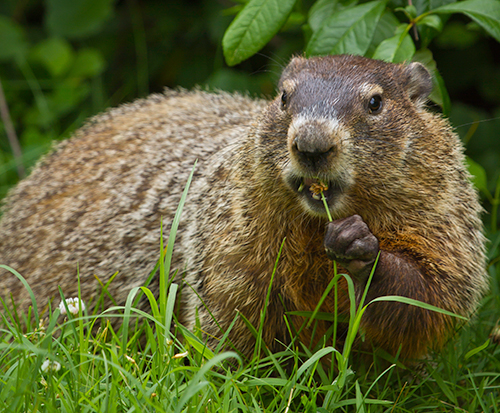
Figure 1: Groundhogs have brown fur with white guard hairs giving it a ‘frosted’ appearance. Photo credit: Shenandoah National Park.
Groundhogs (Marmota monax) belong to the squirrel family Sciuridae, a large group of 285 rodent species including tree, ground, and flying squirrels; chipmunks; prairie dogs; and marmots. There are 15 species of marmots found throughout Europe, northwestern Asia, and North America, all of which are heavy-bodied diurnal animals with relatively short legs and ears. Groundhogs can be found across much of Canada and the eastern United States and are the largest marmot species in the range, weighing 5–15 lbs. and measuring 16–26 inches long. Like all rodents, groundhogs have large incisors, which grow continuously to compensate for the extreme wear and tear they experience from grazing vegetation and gnawing through roots while excavating burrows. Groundhogs typically have yellow-brown to brown fur with white-tipped guard hairs (to protect against moisture and abrasions) covering the entire body (Figure 1). These guard hairs sometimes give groundhogs a ‘frosted’ appearance. Their feet and tail are dark brown or black, and they have white fur around the nose. There is no color difference between males and females, but males are on average 8% heavier than females.
Habitat
Groundhogs are generalist species that can be found in a variety of habitats, including open clearings, woodland edges, roadsides, fields, and riparian areas. They are highly adapted to human-dominated landscapes. As burrowing species, groundhogs spend the majority of their time underground. Using their long, curved claws and strong limbs, groundhogs maintain complex networks of tunnels that can extend 4 to 5 feet beneath the ground surface and up to 30 feet in length. Burrows often contain multiple access and egress points, as well as separate chambers for hibernation. Groundhogs are surprisingly sanitary, even dedicating separate chambers for defecation!
Ecology and Behavior
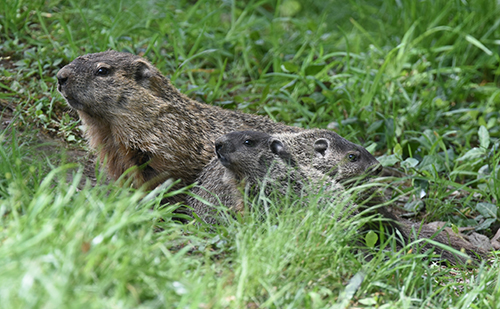
Figure 2: A female groundhog and her kits explore outside their burrow. Photo credit: Andy Reago and Chrissy McClarren.
Groundhogs live an average of 4 to 6 years in the wild and are solitary for most of that time, coming together only to breed. Male and female groundhogs arouse from hibernation for short periods in February, which allows males to establish territories and search for females. During these periods, females stay inside or near their burrows and establish a bond with the visiting male. Both sexes then return to their respective burrows for additional deep-sleep periods before finally emerging in March. This pre-mating courting period allows for breeding to occur rapidly once the animals emerge from hibernation; once a male mates with one female, he will quickly move on to mate with other females in his territory. Birthing early in the season gives young-of-the-year enough time to gain weight during the summer to survive their first hibernation. Females produce one litter of 2–6 young (called kits) per year. Kits are born blind and hairless, and they stay in the safety of their burrow until they are fully furred (Figure 2). After about 2 months of care, the juvenile groundhogs leave their natal site to find their own territories.
Groundhogs spend the summer and fall eating and gaining weight to prepare for the next hibernation cycle which begins in October or November. They can eat up to 1.5 lbs. of vegetation per day during the summer, leading to a 11.5–20-gram weight gain per day, depending on sex and age. Groundhogs eat a wide variety of plant materials and will switch food choices based on local and seasonal availability, as well as individual preferences. In spring groundhogs favor species of clover, which are legumes that provide an easily available source of protein for animals emerging from hibernation. Later in the growing season, groundhogs will seek out various berries, corn, tomatoes, alfalfa, and apples from cultivated fields and backyard gardens (Figure 3). Although they are primarily vegetarians, groundhogs will occasionally consume bird eggs and invertebrates including beetles, snails, and grasshoppers.
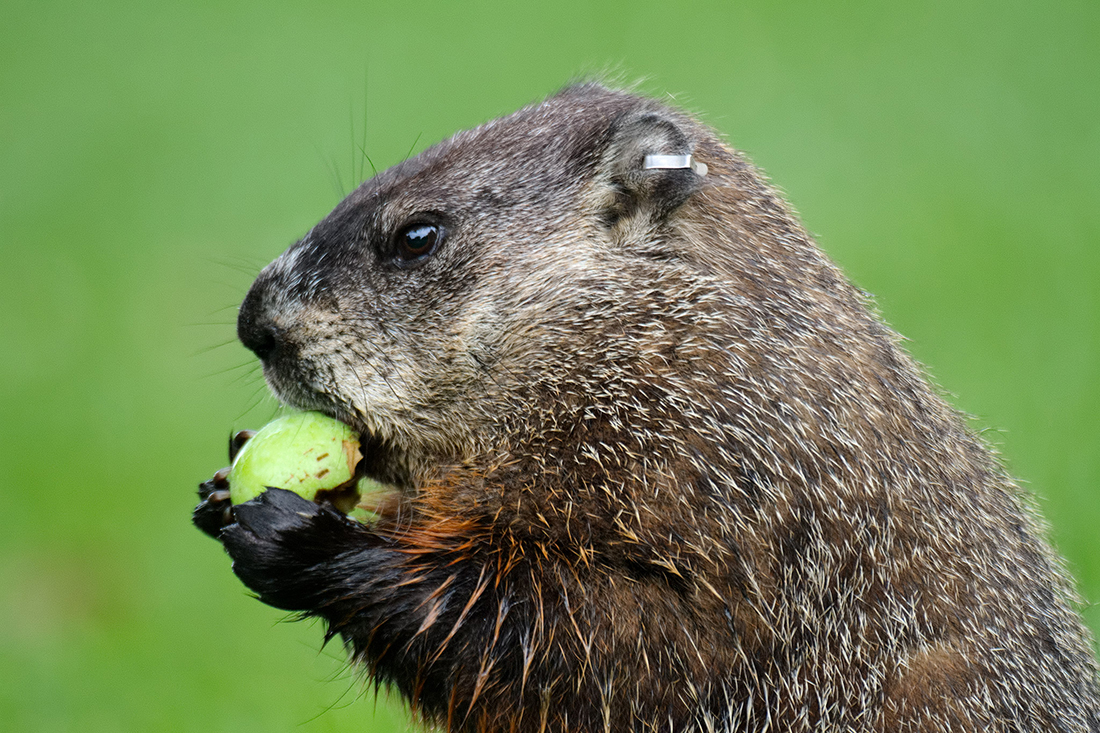
Figure 3: A groundhog eating a green apple. Photo credit: Rick Cameron.
Benefits of Groundhogs to Nature and Society
Ecological
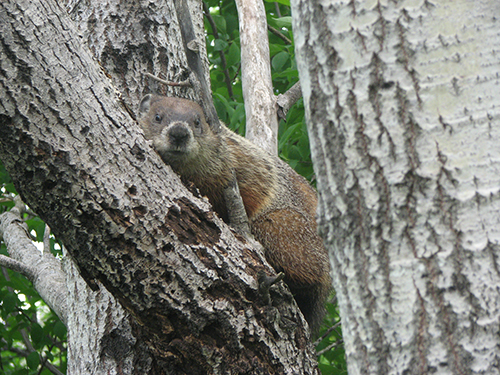
Figure 4: A groundhog in a tree avoiding threats. Photo credit: randombit.
Abandoned groundhog burrows are used by many other wildlife species for shelter and breeding, including cottontail rabbits, raccoons, foxes, river otters, eastern chipmunks, and a wide variety of small mammals, snakes, and birds. Groundhogs are also an important prey item for coyotes, bobcats, eagles, hawks, owls, and weasels.
Disease Research
Groundhogs serve as the best non-human model for studying the hepatitis B virus, which causes liver damage and liver cancer in humans if left untreated. Groundhogs can be infected with a similar disease known as woodchuck hepatitis virus (WHV), which also causes liver cancer. By studying groundhogs infected with WHV, researchers can better understand the pathogenesis of the virus and develop new therapies to treat humans with hepatitis B. Groundhogs have also been used in research involving obesity, endocrinology, reproduction, neurology, and metabolism.
Cultural
Most notable, of course, is the role groundhogs play every February 2nd in the United States as potential harbingers of an early spring. German migrants brought the tradition of Groundhog Day to Pennsylvania in the mid-1800s. According to the myth, if a groundhog (originally a badger or hedgehog in Europe) emerges from its den and sees its shadow, then six more weeks of winter lie ahead. If not, spring is coming early! Besides having their own holiday, groundhog populations have adapted well to human development and are commonly found in parks, golf courses, and gardens in urban and suburban areas.
Hunting
Groundhog hunting season in New Jersey occurs March through September, from sunrise to 30 minutes after sunset. There is no bag limit, and they may be hunted with a bow, rifle, or shotgun. However, it is illegal to rifle hunt groundhogs on wildlife management areas or state parks, forests, and recreation areas. A second season, limited to bows and shotguns, occurs during specific time periods between October and February. Thanks to the Pittman-Robertson Act, which imposes an excise tax on all firearms, ammunition, and arrows purchased within the United States, money used to hunt groundhogs indirectly provides funds for wildlife conservation in New Jersey. Please check the current New Jersey Department of Environmental Protection Division of Fish and Wildlife, Small Game Season Regulations for further details.
Groundhogs as a Nuisance Species
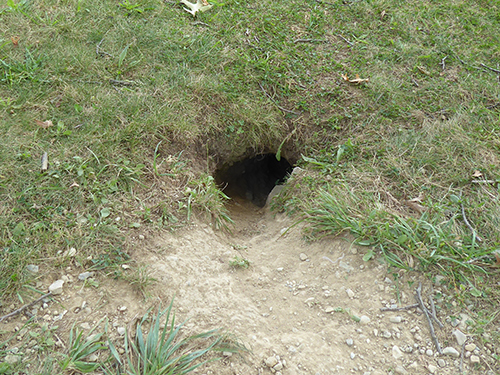
Figure 5: A typical groundhog burrow. Photo Credit: Lorianne DiSabato.
In most cases, a groundhog burrow is not a problem and should be left alone. However, due to the groundhog’s vegetarian diet and their extensive burrow systems, they can sometimes become a nuisance on a local scale (Figure 5). Due to their voracious appetite (consuming up to 1.5 lbs of vegetation per day), groundhogs can quickly decimate a home garden or landscape planting. On agricultural lands, groundhogs can cause costly and extensive damage to crops such as alfalfa, soybeans, squash, tomatoes, and peas. In orchards, groundhogs damage fruit trees by gnawing on main stems, which reduces tree growth rates and increases the chance of pathogenic infection and death.
Groundhog burrows can also damage foundations of buildings and monuments when the tunnels are too close to the structures or paved surfaces. On farms, burrow entrances and tunnels can damage expensive farm equipment and endanger livestock who accidentally step into them. When groundhogs burrow too close to fruit trees in orchards, they injure the trees by causing excessive aeration of the root systems.
Groundhog Management Strategies
Non-lethal Methods
Exclusion
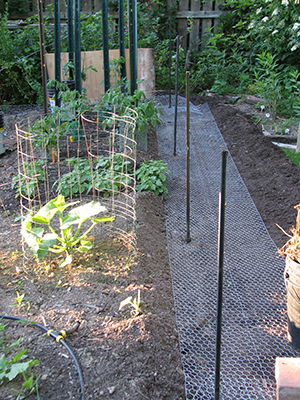
Figure 6: At least 12 inches of fencing must be buried into the ground extending away from the garden. Photo Credit: Janet Allen.
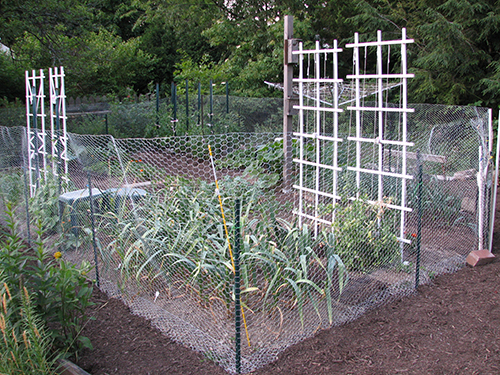
Figure 7: 3-4 ft tall fencing, with the top 12 inches bent outward and unattached to the fence posts. Photo Credit: Janet Allen.
Fencing-in high-value areas, such as vegetable gardens, is the most effective way of reducing groundhog damage in a specific area. Because groundhogs can both burrow under and climb over a standard fence, fencing must be buried 12 inches into the ground, with another 12 inches bent horizontally at the bottom to form an L-shape (Figure 6). This will prevent the groundhog from tunneling under the fence. In addition, fencing should extend 3 to 4 feet above the ground, with the top 12 inches either bent outward at a 45-degree angle or unattached to the fence posts to render it too unstable for a groundhog to scale (Figure 7).
Exclusion material, such as stainless-steel hardware cloth, can also be used to prevent groundhogs from tunneling under structures such as sheds or decks. Attach the material to the lower edge of the structure, and bury it at least 12 inches into the ground, extending it 1 to 2 feet away from the structure. Never install fencing material if there is an active groundhog tunnel present, to avoid trapping groundhogs or other wildlife species under the structure.
Electric fencing provides an additional element of deterrence. If you decide to use electric fencing, place a single strand ~4 inches off the ground and a second strand 8 inches off the ground to deter groundhogs. Electric fence wire and chargers can be easily found at garden and home improvement stores. Chargers either need to be plugged directly into a power source or run on an external battery. Either way, the first step to install an electric fence is to measure the perimeter of the garden or area you are excluding from groundhogs, making sure there is at least one foot of space between the edge of the garden and fence. Trim away any tall grass or excess vegetation that might touch the fence and disrupt the electrical current. Next, drive 2-ft tall support stakes approximately 1-ft deep into the soil, every 3–5 feet around the perimeter. Install plastic insulators on each stake at 4 inches and 8 inches above the ground. Then, thread one strand of electric wire through the insulators at the 4-inch level, until the perimeter is completely enclosed and the wire is tight. Tie the ends of the wire together, and repeat this at the 8-inch level. Last, connect the fence to the charger and properly ground it, making sure to follow the directions provided with the equipment. Once the system is running, use a voltage meter to ensure the fence is powered. Never touch the fence with your hands, and post warning signs around the perimeter.
Eviction
Sometimes groundhogs will burrow under a structure such as a shed or deck. In most cases, a single burrow causes negligible damage. If needed, groundhogs can be evicted using one-way devices that allow the groundhog to exit the burrow but not re-enter. First, the entire perimeter of the structure must be secured using fencing material described above. Then, one-way devices are installed over the burrow entrance holes for at least 2 weeks, to allow all animals to exit the burrow. After this period, the holes are sealed shut. Proper eviction requires attention to groundhog ecology: groundhogs should NOT be evicted during their hibernation or breeding seasons, as there may be individuals that get trapped inside the burrow. These individuals will either die or potentially cause more property damage as they try to dig their way free. Therefore, we recommend consulting a nuisance wildlife control professional if an eviction is desired.
Deterrents
Deterrents for groundhogs work by either preventing the groundhog from crossing a specific perimeter, or by making food sources distasteful or cause momentary pain. Deterrents applied around perimeters are usually made from animal products such as predator urine or dried blood, which aim to induce fear into the groundhog. These can be used around gardens, or around groundhog tunnel entrances to encourage them to abandon the burrow. Deterrents applied directly to plants are typically extracts including capsicum, garlic, or mustard, which mimic the feeling of eating a hot pepper. If you have one or more groundhogs that typically frequent your garden, deterrents will not likely be effective since the animals know there is a food source available.
Live Trap and Relocation
Capturing and releasing a nuisance groundhog in a new location is not a viable option in New Jersey. Because groundhogs are classified as a rabies vector species, relocations outside of the capture site are strongly discouraged. Where on-site release is infeasible, relocations must occur within a 5-mile radius of the capture site within the original township, and with the landowner’s permission. Releases cannot occur on federal, state, county or municipal land without prior permission. See the New Jersey Division of Fish and Wildlife’s Policy on the Relocation of Wildlife (PDF) for more information.
Lethal Methods

Figure 8: A live-trapped groundhog. Photo Credit: Keith Lam
New Jersey law states that property owners experiencing property damage, or farmers experiencing crop and livestock damage due to groundhogs may kill them at any time of the year using legal firearms, ammunition, and other lawful procedures subject to state law and local ordinance. Groundhogs may also be trapped live first and then humanely euthanized. Trap dimensions should be at least 10 x 10 x 24 inches (Figure 8). Bait the trap using cabbage, lettuce, apple slices, or carrots, and change the bait daily. Place the trap near the entrance of the burrow and arrange logs to funnel the groundhog toward the trap. Check the trap at least twice a day so that the groundhog is removed quickly, and close the trap at night to avoid catching non-target wildlife. NOTE: Many towns prohibit weapon discharge of any kind; therefore, other management options should be explored.
Nuisance Wildlife Control Professionals
We recommend calling a professional wildlife control company if you decide to use a lethal method to manage nuisance groundhogs. It is important to remember that reducing the number of groundhogs on your property through lethal means or relocation will not prevent new groundhogs moving in from surrounding areas (or relocated individuals to return!), but it may help reduce grazing pressure in the short-term. In most cases, excluding groundhogs from high-valued areas with fencing works best, depending on the situation.
Unacceptable Methods
References
- Arsenault, J.R. and R.F. Romig. 1985. Plants eaten by woodchucks in three northeast Pennsylvania counties. Proceedings of the Pennsylvania Academy of Science 59(2): 131-134.
- Barash, D.P. 1989. Marmots: social behavior and ecology. Standford University Press
- Bollengier, R.M. 1994. Woodchucks, damage prevention and control methods. In The handbook: prevention and control of wildlife damage (S.E. Hygnstrom, R.M. Timm, G.E. Larson, editors). University of Nebraska-Lincoln.
- Burnett, A.W. 2016. 2016 NJ Firearm Hunter Survey. New Jersey Division of Fish and Wildlife, Nacote Creek Research Station, Port Republic, NJ. www.state.nj.us/dep/fgw/pdf/hunter_survey16.pdf
- Burt, W.H. and R.P. Grossenheider. 1989. A field guide to the mammals of North America north of Mexico, third edition. Houghton Mifflin Company, New York, New York.
- Kwiecinski, G.G. 1998. Marmota monax. The American Society of Mammalogists. Mammalian Species 591:1-8.
- New Jersey Division of Fish and Wildlife. 2014. NJ wildlife relocation policy. New Jersey Department of Environmental Protection. www.state.nj.us/dep/fgw/pdf/relocation_policy.pdf
- New Jersey Hunting & Trapping Digest. 2017. New Jersey Division of Fish and Wildlife njfishandwildlife.com/pdf/2017/trapping_summary17-18.pdf
- Segelken, R. 1996. At Cornell, groundhog is harbinger of health. Cornell Chronical. news.cornell.edu/stories/1996/02/cornell-groundhog-harbinger-health
- Swihart, R.K. 1991. Modifying scent-marking behavior to reduce woodchuck damage to fruit trees. Ecological Applications 1(1): 98-103.
- Swihart, R.K. and P.M. Picone. 1994. Damage to Apple Trees Associated with Woodchuck Burrows in Orchards. The Journal of Wildlife Management 58(2): 357-360.
- Tennant, B.C., and J.L. Gerin. 2001. The woodchuck model of hepatitis B virus infection. ILAR Journal 42(2):89-102. DOI: 10.1093/ilar.42.2.89
- Zervanos, S.M., C.M. Salsbury, and J.K. Brown. 2008. Maintenance of biological rhythms during hibernation in Eastern woodchucks (Marmota monax). Journal of Comparative Physiology B 179: 411-418.
June 2020
Copyright © 2025 Rutgers, The State University of New Jersey. All rights reserved.
For more information: njaes.rutgers.edu.
Cooperating Agencies: Rutgers, The State University of New Jersey, U.S. Department of Agriculture, and Boards of County Commissioners. Rutgers Cooperative Extension, a unit of the Rutgers New Jersey Agricultural Experiment Station, is an equal opportunity program provider and employer.

